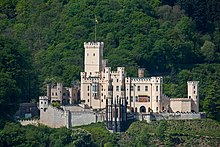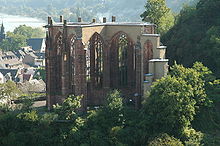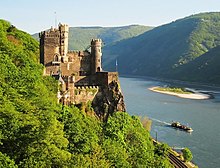Rhine romance





The Rhine Romanticism was the contemporary implementation of the landscape and the legendary history of the Rhine Valley in the cultural-historical epoch of Romanticism , which lasted from the end of the 18th to the late 19th century and found expression in all art genres.
Schlegel's travel notes as an essential contribution
As a reaction to the beginning of industrialization with its negative side effects, writers and artists in particular turned to nature and the past. Friedrich Schlegel describes the impression he made on his journey through the Rhine in 1806: “For me, only the areas that are usually called rough and wild are beautiful; because only these are sublime, only sublime areas can be beautiful, only these excite the thought of nature. [...] But nothing can embellish and reinforce the impression so much as the traces of human boldness on the ruins of nature, bold castles on wild rocks - monuments of the human heroic age, following on from those higher ones from the heroic ages of nature. "
Other authors
The travelogues written in the 1770s and 80s by Johann Wolfgang von Goethe , Friedrich Hölderlin and Heinrich von Kleist on the Rhine can be regarded as forerunners of the romanticism of the Rhine. Lord Byron popularized the Rhine landscape in England with his verse story Childe Harold's Pilgrimage from 1818. The German poet Adelheid von Stolterfoth created numerous Rhine poems. In the visual arts, William Turner attracted the attention of the English, especially with his pictures, which he took on several trips. Not only Turner and the Roman vedute painter Salomon Corrodi , but also many painters of the Düsseldorf School turned to the romantic motifs of the Rhine. The most popular romantic views of the Rhine, which were distributed in reproductions of various formats, including postcards , come from Nikolai von Astudin . Germaine de Staël was one of the first women writers to publish her travelogues on the Rhine in France. Gérard de Nerval wrote his atmospheric travelogue Loreley in 1852 . With the title he tied in with the romantic Loreley myth, which had previously become known through the ballad Lore Lay by Clemens Brentano (1800) and the poem Die Lore-Ley by Heinrich Heine (1824).
In 1840 Victor Hugo published his trip to the Rhine .
Between 1840 and 1843, the composer Franz Liszt created a number of works with Rhine-romantic references, such as The Cell in Nonnenwerth , Im Rhein or The Loreley . Around the same time, Robert Schumann composed the art song Im Rhein, im heiligen Strom as part of the Dichterliebe cycle . His 3rd symphony , the Rheinische , also reflects the romantic moods on the Rhine. Schumann's wife Clara , like Friedrich Silcher and Liszt, dedicated a piece to the Loreley motif. The song Die Wacht am Rhein , set to music by Carl Wilhelm , even bears national- romantic traits, as it defended the Rhine as the “holy land mark” of Germany against ambitions of France and - like Nikolaus Becker , the poet of the popular Rhine song - the political Myth "German Rhine" endeavored (see also Rhine crisis ). Richard Wagner created the romanticism of the Rhine in the form of the legend of the Nibelungenlied, which is located on the Rhine, with his opera cycle Der Ring des Nibelungen, composed between 1848 and 1874, a musical monument that is known worldwide. Carl Zuckmayer delivered a late work of Rhine romanticism in 1925 with the play The Merry Vineyard . In a mixture with roughly realistic and socially critical passages, he let the well-known topos of wine, women and song echo in scenes of Rhenish folk joie de vivre.
From a stopover to a tourist address
The Middle Rhine Valley was visited at the end of the 18th century by travelers such as the Italian Aurelio de 'Giorgi Bertola (first travelogue in romantic style) in 1795 and the Englishman John Gardnor (etchings) in 1787. In 1802, Clemens Brentano and Achim von Arnim toured the valley, which developed from a transit region on the classic educational trip to Italy to a top tourist address. In 1845 Victoria , Queen of Great Britain and Ireland, toured the Rhine Valley.
After Switzerland with its rough Alpine valleys, the rocky Upper Middle Rhine Valley with its many castle ruins became a tourist “must”. Many princes and wealthy private individuals began to rebuild the castles, above all the Prussian royal house, which had acquired the Rhineland through the Congress of Vienna in 1815 and was active there in several places as an expression of the new sovereignty. Stolzenfels Castle near Koblenz , built by King Friedrich Wilhelm IV as a summer residence, is considered to be the most outstanding building of the romantic Rhine era . Parallel his cousin was Friedrich Prince of Prussia , who as a representative of the Hohenzollern monarchy in the Rhine province had used the ruins Vaitzburg in Trechtingshausen for Burg Rheinstein Rhine romantically shape. Even with absolute secular buildings such as tunnel entrances, neo-Gothic or neo-Romanesque buildings were built in the course of Romanticism. A literary source of the romantic enthusiasm of the Prussian royal family for the castles on the Rhine was the chivalric novel Der Zauberring by Friedrich de la Motte Fouqué , published in 1813 .
Popular printmaking
In the first half of the 19th century, the popular image of the romantic Rhine was shaped less by painting and more primarily by graphic art . Aquatints , lithographs and engravings illustrated the travelogues or were published as series of views. Between 1820 and 1830 at least twelve publications with independent new views came out. The English were leaders in the field of steel engraving , patented in London in 1826 , which replaced the copperplate engraving technique and enabled precise representations and high editions. At the time, William Tombleson provided the best models , and 50 engravers converted them into 68 depictions of the Middle Rhine in the Views of the Rhine, first published in 1832 .
A year later appeared Traveling Sketches of Clarkson Stanfield . The steel engraving with the view of Bingen and the Rhine-Nahe-Eck from the other side of the Rhine comes from this publication. The English artist skillfully intensifies the effect of the cityscape with the help of the backlit basilica and the reflecting surface of the water. The geographical reality was largely sacrificed on the altar of the Rhine romanticism. The viewer is looking precisely to the south, and the low sun or a sunset can hardly be expected in this direction. Nevertheless, this charming view is one of the most famous and most copied Binger vedutas of the entire 19th century.
One of the most artistically and technically demanding publications of this time is the series of prints reproducing the entire course of the Rhine by the Swiss publisher and painter Johann Ludwig Bleuler around 1827 . Bleuler's main work, Voyage pittoresque aux bords du Rhin et de la Suisse , appeared around 1845. Also noteworthy are the publications by Karl Baedeker with views of the Rhine by Rudolf Bodmer and Christian Meichelt , which started the publication of the later world-famous Baedeker travel guides .
In 1885, Bernhard Mannfeld's series Vom Rhein published another 15 prints with views of the Rhine, before prints in their function as a mass medium were more and more replaced by photography and the newly developed photographic reproduction processes.
The Upper Middle Rhine Valley has been a UNESCO World Heritage Site since 2002 .
"Views of the Rhine" by William Tombleson (around 1840), ruins of the Werner chapel in Bacharach
St. Goarshausen with Katz Castle , engraving from Ward to Tombleson
Heimburg ruins near Niederheimbach ,
Wellmich with Mouse Castle
Andernach Castle ruins
Ar (g) enfels Castle, Bad Hönningen
Stolzenfels Castle in 1836 shortly before the conversion to a castle
The Loreley
- Pictures 4 to 7 are old colored engravings by Christian Meichelt based on models by Johann Adolf Lasinsky .
literature
- John Gardnor: Views taken on and near the river Rhine, at Aix la Chapelle, and on river Maese. Ellis & Walter, London 1788
- Bertola de 'Giorgi, Aurelio: Viaggio sul Reno e ne' suoi contorni. Rimini, Albertini, 1795.
- Laurenz Janscha : Collection de cinquante vues de rhin . Artaria & Comp. Vienna, 1798. digitized edition from Dilibri accessed on July 9, 2017
- Aloys Schreiber : Picturesque views of the Rhine from Mainz to Düsseldorf , Wilmans: Frankfurt am Mayn 1806
- Aloys Schreiber: Voyage pittoresque sur le Rhin depuis Mayence jusqu'à Düsseldorf . Wilmans: Frankfurt 1807, 2nd verb. and possibly edition (with maps), Engelmann: Heidelberg 1818, 68 p. ( digitized edition )
- Robert Batty : Scenery of the Rhine, Belgium and Holland (4 volumes), 1824. Ed .: R. Jennings, London. digitized edition accessed on July 8, 2017
- Ms. Röhling (Ed.): Rhine journey from Mainz to Cologne. Historically, topographically, and pictorially edited by Prof. Joh. Aug. Klein. With twelve lithographed views of remarkable castles ec. in outline . Koblenz, with Ms. Röhling. 1828. [378 p.] [Proof: dilibri, Koblenz. [1] , accessed August 15, 2011]
- Horst-Johs Tümmers: Rhine romanticism - romance and travel on the Rhine . Cologne 1968, 175 pages, with 107 illustrations
- Gisela Dischner: Origins of Rhine Romanticism in England. On the history of romantic aesthetics . Frankfurt / M .: Vittorio Klostermann 1972
- Carl Trog: Rhineland's wonder horn. Stories and legends tell, also intrigues and taunts from the old knight's castles, monasteries and cities on the banks of the Rhine and the Rhine region, from the sources to the mouth of the river. Dedicated to the German people by Carl Trog. 15 vols. Alfred Silbermann, Essen a. Leipzig 1882–83. Mikado, Atzbach 1980 (reprint). ISBN 3-8124-0011-1 (Vol. 1)
- Marianne Bernhard (afterword): The picturesque and romantic Germany. The vedute of the travel work from the years 1836–1841 . Dortmund 1979 (The bibliophile paperbacks, 2nd edition 1980)
- Kurt Eitelbach: The romantic Middle Rhine - oil paintings and watercolors from Koblenz and Rhenish private collections . (Exhibition catalog of the Middle Rhine Museum Koblenz) Koblenz 1983
- Art guide - Koblenz and the Middle Rhine - with special section : Rhine romanticism in the 19th century , Hamburg 1984: HB - Volume No 9, Verlags- und Vertriebs-GmbH, 99 p., With numerous. Color fig.
- Bertil Fuchs Collection: Rhine Romanticism in Painting / Travel Literature and Applied Arts from the beginning in the 17th century to the end in the 19th century (16 color plates, 33 picture plates). Kunsthaus am Museum (Carola van Ham), auction 104 A, Cologne 1, 23 May 1985
- Wenzel Hollar : Travel pictures from the Rhine , catalog Landesmuseum Mainz 1987
- Dieter Kerber, Martina Kerber and Ernst Lutsch (arrangement): Castles and palaces of the Rhineland on postcards (catalog for the special exhibition of the Middle Rhine Postal Museum Koblenz in Eltz Castle from September 2 to October 31, 1992) Koblenz 1991
- Michael Schmitt: The illustrated descriptions of the Rhine. Documentation of the works and views from the Romantic period to the end of the 19th century [with approx. 10,000 references] Cologne 1996. ISBN 3-412-15695-7
- Hans Joachim Bodenbach: Christian Meichelt , engraver and painter in Basel, teacher in Lörrach , - also working for the Koblenz publishing house Karl Bädeker (Baedeker) , in: Badische Heimat, 4/2000, Freiburg i.Br. 2000, pp. 700-713. 7 Fig. ISSN 0930-7001 , publisher: Landesverein Badische Heimat eV Freiburg.
- Hans Joachim Bodenbach: VUES DU BORDS DU RHIN. A Rhine album from the early 19th century with aquatint engravings from the Koblenz publishers Fr. Röhling and K. Bädeker (Baedeker) in one volume. - The views published by Röhling . In: Bonner Geschichtsblätter, Volume 49/50, Bonn 1999/2000 (2001), pp. 285–304, with 20 illustrations / of which 17 [in the original old colored] aquatint engravings by Rudolf Bodmer . Bonn 2001
- Hans Joachim Bodenbach: 200 Years of Romanticism on the Rhine - VUES DU BORDS DU RHIN - Views of the Rhine from the publishing house Karl Bädeker (Baedeker) in Koblenz , in: Contributions to the Rhine customer (Rhein-Museum Koblenz), issue 54/2002, Koblenz 2002, p. 26– 55, 30 fig.
- Matthias Schmandt: Rheinromantik, publication accompanying the exhibition in the Historisches Museum am Strom - Hildegard von Bingen. Binger museum booklets. Vol. 2. Bad Kreuznach 2002. ISSN 1617-0415
- Helga Arend: Competing images of women in the sagas of the Rhine. In: Rheinreise 2002. Romance, travel, realities. Women's life on the Rhine. Edited by Bettina Bab and Marianne Pitzen. Edition Lempertz, Bonn 2002, pp. 70-75. ISBN 3-933070-29-5
- Guido Saure: A very special place , cultural and landscape guide through the Upper Middle Rhine Valley. [With colored map from Bingen to Koblenz]. Koblenz: Verlag Ney 2003, 136 p. (With many color illustrations)
- Anneli Karrenbrock: Romanticism on the Rhine and Lahn - On the trail of reality and enthusiastic transfiguration . In: Heimatjahrbuch 2003 Rhein- Lahn -Kreis, Bad Ems 2003, pp. 43–50, 3 figs.
- Irene Haberland: Between art and commerce - Illustrated books on the Rhine from the 17th to 19th centuries from the holdings of the Rheinische Landesbibliothek Koblenz. State Library Center Rhineland-Palatinate, Koblenz, 2005.
- Mario Kramp, Matthias Schmandt (ed.): The Loreley - A rock in the Rhine. A German dream , catalog manual for the exhibition, 214 pages with 150 color illustrations, Mainz (Philipp von Zabern) 2004. ISBN 3-8053-3369-2
- Klaus-Peter Hausberg: "Rhenish Legends & Stories" . The companion book to the Rheinischer Sagenweg with the most famous and beautiful sagas and stories from the Rhine, Moselle, Lahn and Nahe. Supplemented by tourist information. JP Bachem Verlag, Cologne 2005. ISBN 978-3-7616-1986-5
- The Rhine. A literary travel guide. Edited by Gertrude Cepl-Kaufmann , Hella S. Lange. Scientific Book Society, Darmstadt 2006. ISBN 978-3-534-18919-9
- Angela Pfotenhauer / Elmar Lixenfeld: Upper Middle Rhine Valley - World Heritage - From Bingen and Rüdesheim to Koblenz , Bonn 2006: German Foundation for Monument Protection, 370 color. Fig.
- Karsten Keune (Ed.): Longing for the Rhine. Rhineland regions in painting . With contributions by Irene Haberland and Elmar Scheuren. Bouvier Verlag, Bonn 2007. ISBN 3-416-03096-6
- Elisabeth Mick: With the mouse on a Rhine journey - 2000 years of history from Düsseldorf to Mainz . JP Bachem Verlag, Cologne 2007. ISBN 978-3-7616-2069-4
- R. Zado (Ed., Edition Blattwelt): Castles, Vines, Stones - Places and Paths along the Rhine from Bonn to Bendorf , Volume I, ISBN 3-936256-27-6 , Review in: Contributions to Rheinkunde, Koblenz 2008, Issue 59/60, 2007/08, p. 107
- H. Arnold, J. Beckmann and J. Borg (eds.): Rhine - a reading seduction , [poems, songs, stories], Fischer Taschenbuch Verlag 2009, 283 S. Review in: Contributions to Rheinkunde, Heft 61/2009, Koblenz 2009, pp. 59-60
- Karsten Keune (Ed.): The Rhine - Stream of Romanticism. Painting from the RheinRomantik collection. Bonn 2011, ISBN 978-3-86568-733-3 .
- Michael Prince of Prussia (Hrsg.): The Prussians on the Rhine - castles, palaces, Rhine romanticism. Cologne 2011.
- Peter Forster (Ed.): Rheinromantik: Art and Nature. Museum Wiesbaden 2013, ISBN 9783795427108 .
- Hohmann, Bunzel, Sarkowicz (eds.): Romanticism on the Rhine and Main. A topography. Philipp Zabern, Darmstadt 2014.
- (aro) [author]: Revolution with watercolors: Two hundred years of Rhine romanticism , in: Frankfurter Allgemeine Zeitung, Frankfurt am Main, issue of August 19, 2017, No. 192, under features on p. 11 (with a large color illustration of a painting by the English Painter William Turner)
- Klaus-Dieter Regenbrecht : A myth is measured - the Rhine, romance and new spatial experience, essay, Tabu Litu Verlag, Koblenz 2019. ISBN 978-3-925805-91-2
Web links
- Rhineland regions in painting
- History of the Middle Rhine on "regionalgeschichte.net"
- Josef Wewerka: Rhenish castles and legends , pictures and texts
- Adelheid von Stolterfoth: Rheinischer Sagen-Kreis, 1835 , texts
- Karl Christian Koehler: Views of the Rhine and Ahre
- Pictures of the romanticism of the Rhine by JA Lasinsky
- Oh you beautiful German Rhine , music video on the YouTube portal
- William Turner Route
Individual evidence
- ↑ In: Ernst Behler: Friedrich Schlegel in self-testimonies and image documents . 5th edition. Rowohlt Taschenbuchverlag, Reinbek bei Hamburg 1988, ISBN 3-499-50123-6 , p. 100 f.
- ↑ Roswitha Oschmann: Siebengebirgsmuseum shows "Legends and Castles on the Rhine" . Article from November 16, 2013 in the portal general-anzeiger-bonn.de , accessed on November 19, 2013
- ^ Mother Germany , article from May 26, 2008 in the faz.net portal of the Frankfurter Allgemeine Zeitung, accessed on December 23, 2012
- ↑ http://www.regionalgeschichte.net/fileadmin/Superportal/Bibliothek/Autoren/Aversano-Schreiber/Rheinreise-Victor-Hugos.pdf
- ↑ Thomas Kliemann: How the Prussians discovered the romanticism of the Rhine . Article from December 7, 2013 in the portal general-anzeiger-bonn.de , accessed on December 8, 2013















